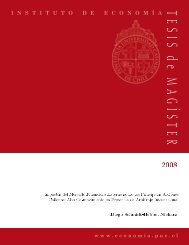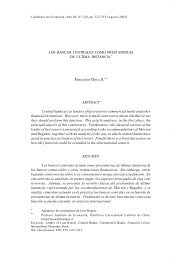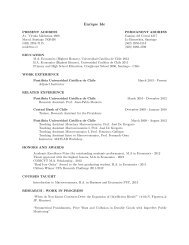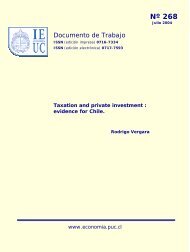TESIS de MA GÍSTER - Latin American Journal of Economics
TESIS de MA GÍSTER - Latin American Journal of Economics
TESIS de MA GÍSTER - Latin American Journal of Economics
Create successful ePaper yourself
Turn your PDF publications into a flip-book with our unique Google optimized e-Paper software.
Luego la restricción presupuestaria <strong>de</strong>l hogar es 50 :<br />
wL c(b + r + d) + p b b + wh(r) + wg(d) (4)<br />
don<strong>de</strong> el costo en tiempo <strong>de</strong> reciclar y disponer ilegalmente la basura crece <strong>de</strong> manera positiva<br />
y creciente a medida que aumenta el material que se dispone <strong>de</strong> estas formas, es <strong>de</strong>cir:<br />
h r > 0; h rr > 0<br />
g d > 0; g dd > 0<br />
Activando la condición en que m = b + r + d, el comportamiento <strong>de</strong> los hogares se resume en<br />
maximizar (3) sujeto a (2) y (4):<br />
max fb;r;dg u [c(b + r + d)]<br />
s:a:<br />
wL c(b + r + d) + p b b + wh(r) + wg(d)<br />
(5)<br />
Las condiciones <strong>de</strong> primer or<strong>de</strong>n (CPO) <strong>de</strong>l problema (5) son:<br />
[b] :<br />
[r] :<br />
[d] :<br />
[] :<br />
u c c m [c m + p b ] = 0<br />
u c c m [c m + wh r ] = 0<br />
u c c m [c m + wg d ] = 0<br />
wL c(b + r + d) p b b wh(r) wg(d) = 0<br />
(6)<br />
La interpretación <strong>de</strong>l sistema (6) es simple. El hogar genera basura hasta que la utilidad<br />
marginal <strong>de</strong> cualquier tipo <strong>de</strong> disposición iguale al costo. A partir <strong>de</strong> este sistema se recuperan<br />
las <strong>de</strong>mandas por servicios <strong>de</strong> recolección, transporte y disposición …nal <strong>de</strong> los residuos <strong>de</strong>l<br />
hogar, el material reciclado, y la cantidad <strong>de</strong> basura ilegal. Suponiendo el vector <strong>de</strong> precios<br />
p = (1; w; p b ), las <strong>de</strong>mandas serían:<br />
b = b(p)<br />
r = r(p)<br />
(7)<br />
d = d(p)<br />
En el agregado, consi<strong>de</strong>rando que existen n hogares, la cantidad generada <strong>de</strong> <strong>de</strong>sechos para<br />
los distintos tipos <strong>de</strong> disposición son:<br />
B(p) = nb(p)<br />
R(p) = nr(p)<br />
D(p) = nd(p)<br />
(8)<br />
50 Se asume que el precio <strong>de</strong>l bien <strong>de</strong> consumo es numerario, luego p c = 1.<br />
31






